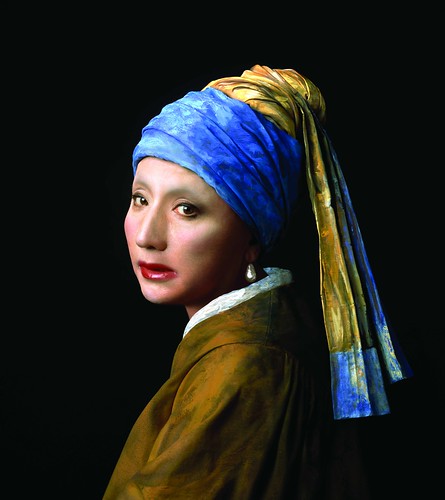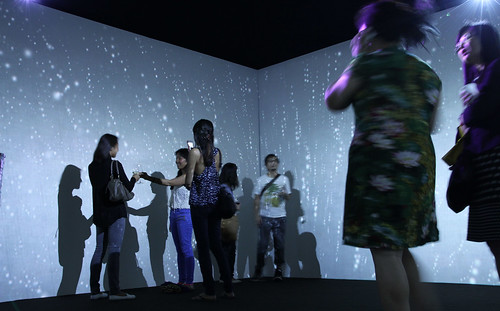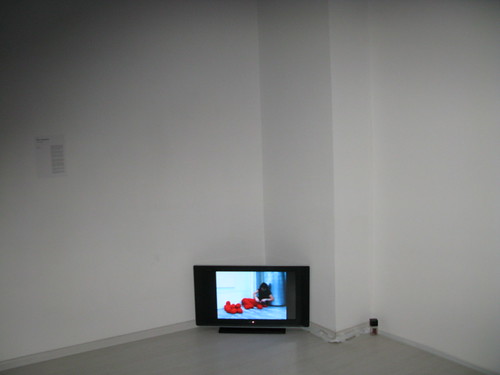Transition has been on my mind of late. Maybe that’s why I gravitated towards the insight noted in The Experience Machine’s catalogue essay on the industrial age making way for the “electronic era”, allowing for renewed “ways of seeing and experiencing our world”.

John F. Simon Jr., “Endless Victory”, Software, Apple Powerbook G4, acrylic plastic
How then does our current electronic era influence art? More than ever, artists are using technological advances to alter and challenge their practices and processes, giving rise to ‘New Media Art’, which comprises “constantly evolving hybrid technological art forms such as video art, digital art, interactive installation and customized software art”. The semantics of art then comes into question. Can the programmed digital software John F. Simon Jr. used to create what I heard some visitors call a “Microsoft screensaver” be called art? Ambivalence about popular acceptance of such unfamiliar art forms has clearly not deterred co-curator and owner of Ikkan Art International, Ikkan Sanada, from presenting a plethora of unconventional, tech-savvy and wonderfully bizarre works that the local art scene has probably not yet witnessed. After all, what is transition without the slight discomfiture and strange newness of change?

Morimura Yasumasa, “Vermeer Study: Looking Back (Mirror)”, C-type print mounted on canvas
With change comes a reconfiguration of habits and customs. Technology allows and promotes the manipulation and reconstruction of our visual, social and perceptive norms, engendering new sights and experiences that challenge the beliefs we have become used to. Iconoclastic and irreverent, Morimura Yasumasa’s contemporary takes on the historically famed Vermeer painting, Girl with a Pearl Earring, challenge art-historical and social ideas regarding the male gaze. By reconstructing his Japanese, male identity into that of a Western, female figure, Morimura subverts the conventional notions associated with the invasive, voyeuristic male gaze, confounding the viewer and prompting him to look beyond the superficiality of representation. He employs more physical reconstruction and metamorphosis than technological (although his use of video alone in the appropriation of Vermeer inserts a wholly new artistic dimension and comparison): notorious for being contemporary art’s “most famous drag queen”, Morimura paints his face and painstakingly transforms his sartorial, facial and overall physical appearance to that of his subjects. From artist to subject (and object), male to female, Asian to Western, hidden to exposed, Morimura boldly appropriates a revered historical piece, only to playfully, completely turn it on its head.

SISYU+teamLab, “What a Loving, and Beautiful World”, Interactive animation installation
One of the things I love about contemporary art is its ability to engage audiences in participation and dialogue. Performance alone does not suffice, as the distance between artist and audience is sorely emphasized. By engaging the senses and encouraging activity, art ceases to be a hierarchical distinction and moves into a new realm of participation, reflection and agency.
The magnum opus of The Experience Machine is SISYU+teamLab’s installation that presents a visually captivating spectacle, allows visitors to participate and act, and uses technology to reflect, not manipulate or violate, a natural milieu. Upon walking into a specially constructed black room, I was surrounded by screens depicting a surreal, otherworldly 3D landscape of nebula and falling kanji (Chinese characters). Intrigued, Mr. Sanada then prompted me to ‘touch’ a falling character. My action caused the kanji signifying ‘bird’ to transmogrify into an animated version of a bird. Mr. Sanada then proceeded to enliven ‘tree’, which the bird then flew to. This is just one of many instances of the everyday, arbitrary interactions between nature, the elements and animals that the installation mirrors with surprising accuracy. While we might often think of technology as automated, soulless and clinical, What a Loving, and Beautiful World demonstrates how SISYU+teamLab has invigorated their animation with the unpredictability and simple beauty of nature.
Bea Camacho, “Enclose”, Single-channel video, 11 hours
While some might get lost in SISYU+teamLab’s technological playground, my favourite work from the show was unenviably positioned in a quiet corner in the neighbouring room. Walk into the room flashing with Jim Campbell and Ben Rubin’s light installations, and you might just leave without noticing Bea Camacho’s video, located on the floor in a corner next to the door. Interestingly, the artist herself made the curatorial decision to place her video screen in a negligible place.
Enclose isn’t meant to scream out at you. On the contrary, as the title suggests, it wants to be hidden, isolated. Besides forcing the viewer to bend, squint and make a physical effort to watch her video, Camacho has refused to make Enclose a performance piece, isolating herself from the glare and scrutiny of a surveying audience and their emotional and auditory responses. By choosing not to sensationalize her emotions, Camacho makes a bold statement about artistic and personal integrity. Enclose is thus poignant because it is an act of catharsis, not a lurid, effusive spectacle.
Having never been physically or emotionally close to her family, Camacho channels the rejection and loneliness she experienced (or is experiencing) by literally ensconcing herself in a crocheted cocoon. While crochet might evoke memories of familial warmth and affection, for Camacho, it refers to “an idealized version of home”. Challenging the futility of fulfilling a romanticized fantasy, Camacho pushes herself to physical extremes by crocheting non-stop for 11 hours, going without rest, food or water. The artist as sufferer, a familiar concept popularized by Marina Abramovic, is here given new life by Camacho, who allows us to witness and experience her pain vicariously through her creative process. As The Experience Machine shows, this shiny new electronic age has more heart than we might think.
*
The Experience Machine is curated by Ikkan Sanada & Andrew Herdon and features work by Bea Camacho, Jim Campbell, Vuk Cosic, John Gerrard, Miao Xiaochun, Morimura Yasumasa, Ben Rubin, John F. Simon Jr. and SISYU+teamLab. The exhibition runs from 13 September – 27 October 2012 at Ikkan Art Gallery. Opening hours: Tues – Sat, 12 – 7pm.

Wong Bing Hao
is an independent art writer. His primary interests include performance, performativity, social practice, institutional critique and the public within contemporary art. He currently reads History of Art at University College London.
